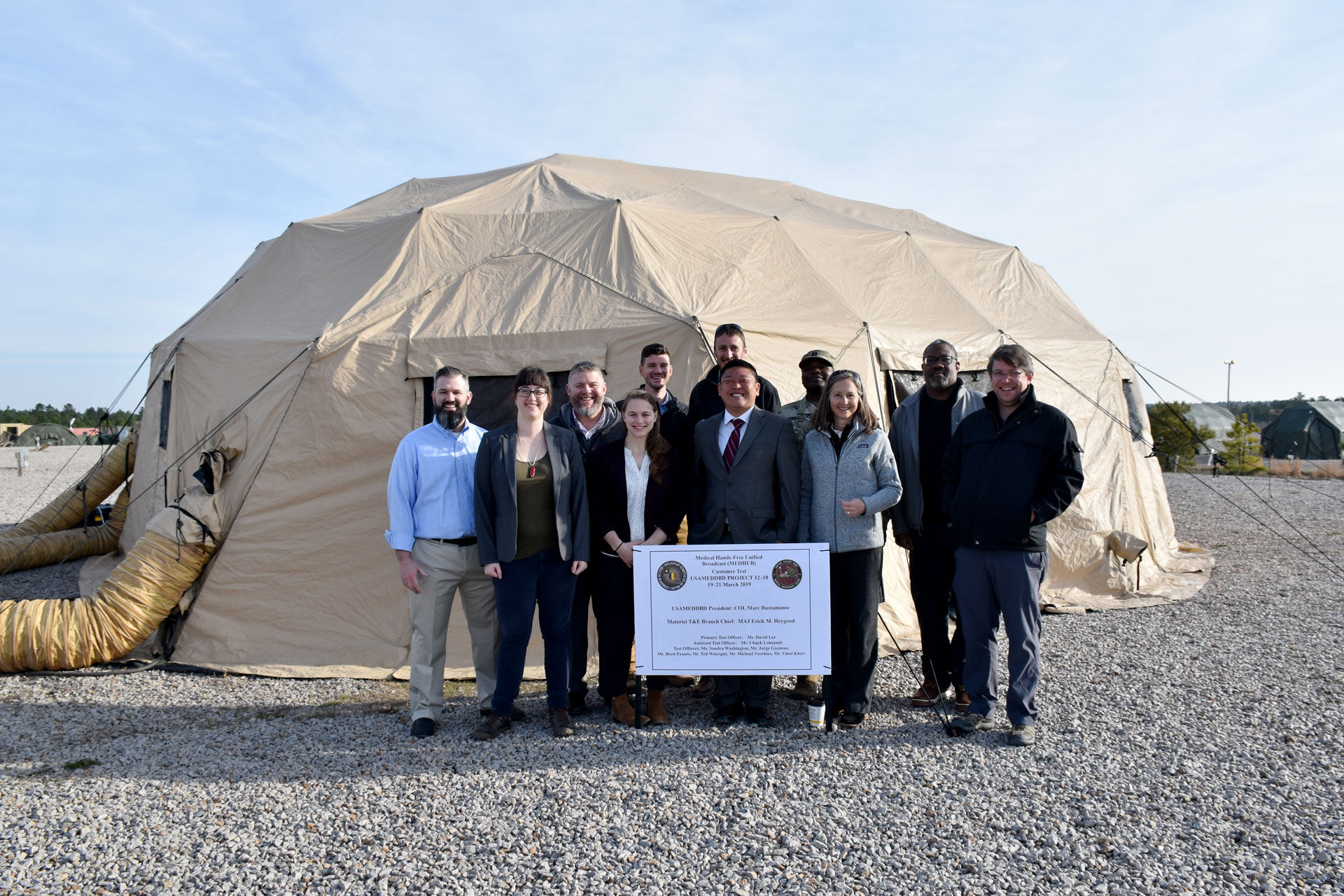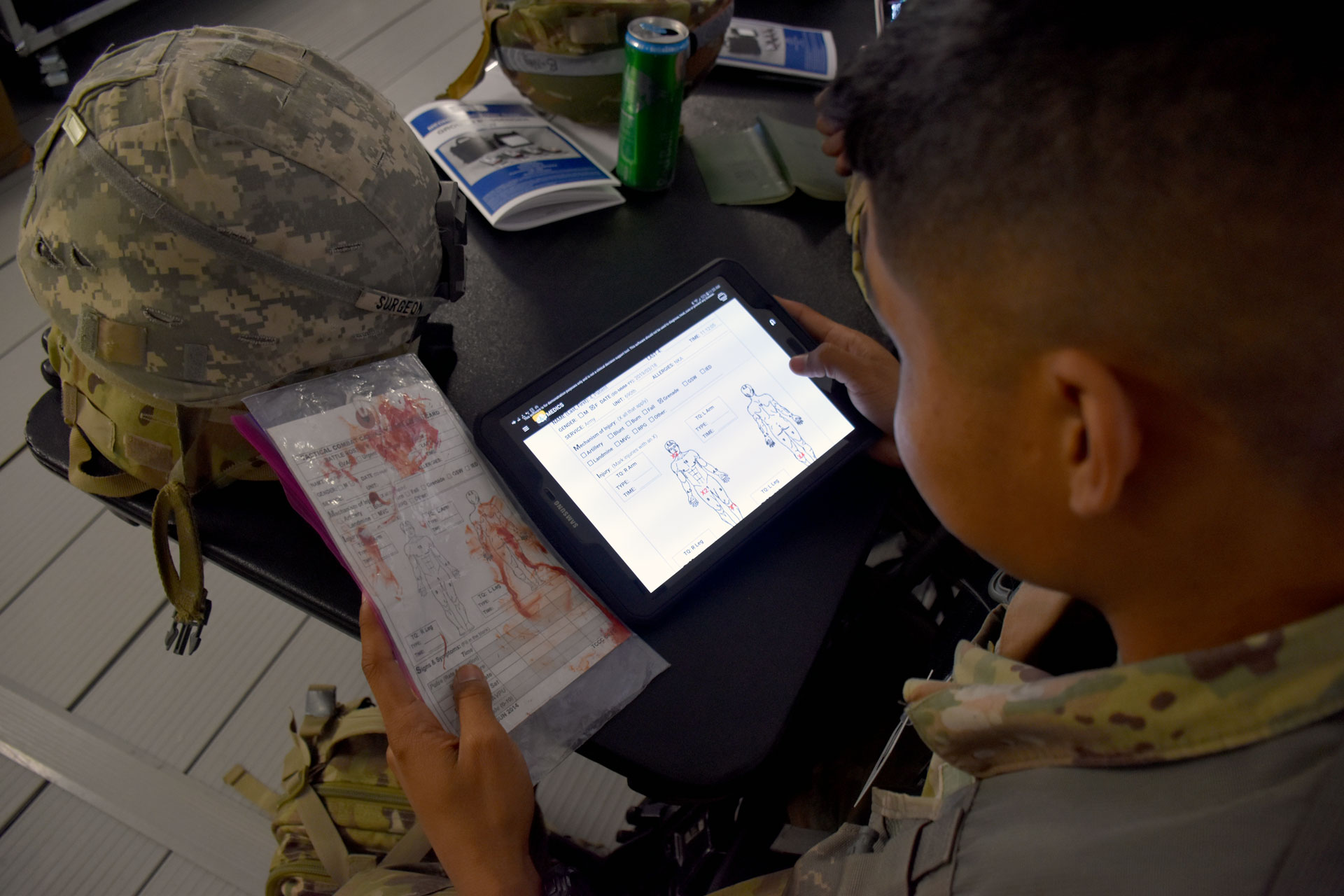
Effective, innovative and agile medical product development fast-tracks MEDHUB device to warfighters.
by Jay Wang
Progress and change always go hand-in-hand. This is especially true for the latest changes affecting the U.S. Army Medical Research and Development Command (USAMRDC) as it transitions from the U.S. Army Materiel Command to the recently formed U.S. Army Futures Command (AFC).
The “progress” side has required aligning USAMRDC values with AFC’s core principles. Because of this, USAMRDC’s approach to medical product development will become even more agile to successfully deliver medical solutions to the warfighter.
AFC’s core principles include the following:
- Effective: We must deliver what warfighters need, when they need it, in a timely and affordable manner.
- Innovative: We must create and cultivate a culture that front-loads smart risks through iteration and prototyping.
- Agile: We must be willing to fail early and responsibly and learn from our failures and successes. We must be creative and not become victim to a “that is not how we do it here” mentality.
- Unified: We must become “one team” with a laser focus on creating speed through shared goals and understanding, disciplined initiative, enabled decision-making at the lowest level, and delivering valued outcomes for the Army.
Dawn Rosarius, a Senior Executive Service member and the USAMRDC’s principal assistant for acquisition, exercises program management and acquisition oversight of the USAMRDC’s product development and procurement programs. Under her guidance, numerous military medical products within the USAMRDC are progressing successfully through the development pipeline.
“In many cases, I believe the USAMRDC already aligns to many of the AFC’s core principles, as well as the mission of the assistant secretary of the Army for acquisition, logistics and technology to develop, acquire, field and sustain the world’s best equipment and services,” said Rosarius. “With some of our medical solutions, we certainly are agile and effective in delivering quality sustainable solutions as efficiently as possible, to ensure we get the best product to our warfighters.”
The Medical Hands-free Unified Broadcast (MEDHUB) system is a clear illustration of the AFC’s tenets being incorporated into the critical work of the Medical Research and Development Command. MEDHUB is a product within U.S. Army Medical Materiel Development Activity’s (USAMMDA) Warfighter Health, Performance and Evacuation Project Management Office. USAMMDA’s mission is responsible for developing and delivering quality medical systems to protect, treat and sustain the health of service members worldwide. MEDHUB is an automated electronic medical documentation and communication system designed to improve the way medics and hospitals share patient information, such as vital signs, injuries and treatments, during medical evacuations.
FIRST, AN EARLY FAILURE
The Transport Telemedicine System program originated in 2013; its goal was bidirectional communications, also known as telemonitoring. The first, manually intensive system was tested in 2017 with senior Army flight medics. The user feedback was definitive: “We cannot document while treating multiple patients at the same time; this would be thrown out of the helicopter.”
This 2017 test led to the program “failing early.” Following that failure, a team of engineers working within the Warfighter Health, Performance and Evacuation Project Management Office changed direction and initiated a new MEDHUB concept to reduce medic burden and to alert and prepare a hospital for en-route patients through telemonitoring. With the help of acquisition professionals and industry partners, the program underwent a novel acquisition strategy that entailed rapid agile prototyping and accelerating the program schedule.
While investigating the significant medical documentation gap on the battlefield, the product team discovered additional hindrances that exist during medevac missions and patient care in the deployed environment. Field hospitals lack situational awareness of incoming patients’ injuries and treatments because of limited communication networks between ambulances and hospitals. The effects are felt at the hospital when the medic must provide a short verbal report in a noisy, high-stress environment at time of arrival. These short verbal reports may not be comprehensive and are not available for further reference by the attending physician.

TEAM EFFORT
Participants at a MEDHUB test in March included: in front row from left, Alexandra Cholewczynski, Emily Krohn and the author, USAMMDA; Jan Cooke, Sierra Nevada Corp.; Mike Moore (U.S. Army Combat Capabilities Development Command – Aviation & Missile Center (CCDC-AVM)); and, in back row, Cory Anderson, CCDC-AVM; Duston Thompson, Sierra Nevada; and JT McNeil, Spencer Brooks, Capt. Gerrod Gomez and Torrence Moore, USAMMDA. PEO Soldier, PEO Aviation and PEO C3T also contributed. (Photo by Ashley Force, USAMMDA Public Affairs)
‘TIME IS TISSUE’
MEDHUB was designed to automate and improve communication. Today’s MEDHUB system leverages wearable medical devices cleared by the U.S. Food and Drug Administration to streamline communication between medics and receiving field hospitals.
The MEDHUB system includes a dashboard display at the receiving hospital, so clinicians can identify the number and status of inbound patients and the estimated time of arrival, instead of relying solely on the verbal reports from a medic. MEDHUB alerts the hospital before patients arrive, earlier than the current radio call, which gives hospital personnel extra time to plan for patient arrival by gathering the supplies and manpower necessary to effectively treat the patients once they arrive. MEDHUB simplifies patient care by providing a vital signs monitor for every patient, so the medic does not have to switch monitors between patients, and it provides additional drug safety through dosage calculators and visual cues for the medic.
“Why is this important? Because time is tissue,” said Lt. Col. Christian Cook, deputy project manager for the Warfighter Health, Performance and Evacuation Project Management Office. “If receiving facilities know what types of injuries they need to treat―what type of blood they need to thaw―they can better prepare to provide emergency medical care when the ambulance or helicopter arrives with the patients.”
As a former medevac pilot, Cook understands the harsh reality of emergency medical evacuations and the importance of time in saving lives. “Minutes may be the difference between life and death,” he said.
SAVING TIME AND MONEY
Throughout the acquisition process for MEDHUB, USAMMDA project and program managers oversee cost, schedule and performance. In keeping with the AFC principles, the MEDHUB product team focused on meeting an aggressive schedule through frequent operational evaluations. A new MEDHUB prototype was built and tested every six months for Soldiers to evaluate.
MEDHUB went from a concept on paper in March 2017 to a product that completed testing in an operationally relevant environment just two years later. Three different prototypes were tested with Soldiers in those 24 months, during which time the product’s Technology Readiness Level increased from 4 (validation in a laboratory environment) to 8 (completion and qualification through test and demonstration).
The system’s performance was managed through discussions of the technical product capability with the vendor twice a week, starting with the paper concept in 2017. These biweekly discussions helped to define and create a product based on the requirements in a fast, efficient and cost-effective manner. This strategy for rapid development led to $15 million in cost avoidance by reducing the program schedule by two years.
To solve the lack of dedicated medical satellite radio networks, MEDHUB uses existing DOD tactical communication satellites connected to transceivers in tactical vehicles. Instead of having the commercial vendor be the prime network integrator, the Warfighter Health, Performance and Evacuation Project Management Office collaborated with the DOD communication commands that are the Army experts in satellite networks to provide dedicated bandwidth for MEDHUB. An integrated product team was formed that worked across program executive offices (PEOs), consisting of members from the PEO for Command, Control and Communications – Tactical, PEO Aviation and PEO Soldier. This team played a key role in MEDHUB’s overall integration with existing and developmental technologies.
Leveraging the existing DOD tactical network and Army tactical handhelds, modems and transceivers on MEDEVAC vehicles—and implementing the AFC tenets of innovation and agility—further reduced cost and time to field.

COLLECTION POINT
With MEDHUB, medics can use a tablet to complete a Tactical Combat Casualty Care Card electronically. At the receiving hospital, clinicians can see the data for incoming patients and ensure that they have proper staff and equipment on hand for treatment. (Photo by Ashley Force, USAMMDA Public Affairs)
CONCLUSION
Today, the MEDHUB prototype is in a prolonged developmental test with the 44th Medical Brigade and Womack Army Medical Center at Fort Bragg, North Carolina. During the 24-month study, which is in preparation for MEDHUB fielding in 2021, health care providers are using the system to provide more complete medical documentation of care for drop-zone casualties, and to alert and prepare Womack Army Medical Center for such casualties. This continued testing ensures the best possible product is fielded to the Soldier.
“The MEDHUB team is passionate and truly committed to the warfighter,” said Col. Ryan Bailey, former USAMMDA commander. “Their commitment demonstrates that working closely with industry, collaborating with other program executive offices along with the user community, you can quickly develop and test a system, make fixes and keep pressing to deliver a capability that will ultimately make a difference.”
The rapid development of the MEDHUB system can be credited to the product team’s consistent, inventive and agile development and test strategy—which certainly can be modified and applied throughout DOD for product development. This acquisition approach will help the MEDHUB program reach milestone C within three years, and it exemplifies how the USAMRDC is following the AFC lead in quickly and effectively delivering novel capability to the Soldier.
“The MEDHUB team has been extremely innovative in finding solutions and development pathways to reduce time and still deliver a quality solution that can be used to assist our medics and clinicians in having the data they need to save more lives,” said Rosarius.
With USAMRDC’s support over the past three years, and especially with the encouragement of Rosarius, the MEDHUB team has successfully navigated acquisition pathways to produce a critical and necessary communication system that may be used by both military and civilian medical personnel. In creating this lifesaving product, the MEDHUB team clearly reflects AFC key principles in its willingness to learn from failure, listen to the user, and rebound toward success.
For more information on the MEDHUB program and other projects being developed by the USAMMDA, go to the organization’s website at https://www.usammda.army.mil/.
JAY WANG is a product manager for the USAMMDA’s Warfighter Health, Performance and Evacuation Project Management Office at Fort Detrick, Maryland. He holds a master’s degree in program management from the Naval Postgraduate School in Monterey, California, a master’s degree in organic chemistry from the University of California, Los Angeles and a bachelor’s degree in chemistry from the University of California, Berkeley. A member of the U.S. Army Acquisition Corps, he is Level III certified in program management, and he is a Lean Six Sigma Green Belt. In 2014, he received the Superior Civilian Service Award for his work at the Joint Program Executive Office for Chemical and Biological Defense for innovatively managing and analyzing a complex acquisition program.
This article is published in the Fall 2019 issue of Army AL&T magazine.
Subscribe to Army AL&T News – the premier online news source for the Army Acquisition Workforce.
![]() Subscribe
Subscribe







